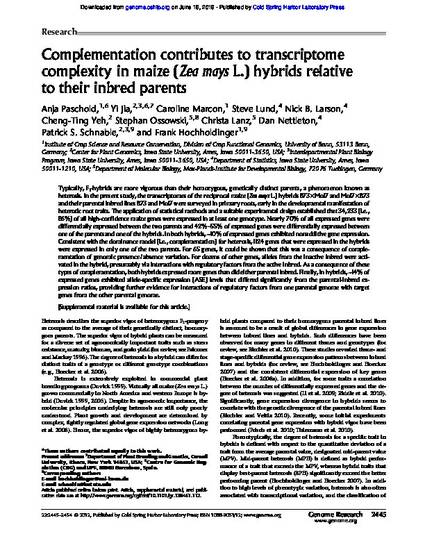
Typically, F1-hybrids are more vigorous than their homozygous, genetically distinct parents, a phenomenon known as heterosis. In the present study, the transcriptomes of the reciprocal maize (Zea mays L.) hybrids B73×Mo17 and Mo17×B73 and their parental inbred lines B73 and Mo17 were surveyed in primary roots, early in the developmental manifestation of heterotic root traits. The application of statistical methods and a suitable experimental design established that 34,233 (i.e., 86%) of all high-confidence maize genes were expressed in at least one genotype. Nearly 70% of all expressed genes were differentially expressed between the two parents and 42%–55% of expressed genes were differentially expressed between one of the parents and one of the hybrids. In both hybrids, ∼10% of expressed genes exhibited nonadditive gene expression. Consistent with the dominance model (i.e., complementation) for heterosis, 1124 genes that were expressed in the hybrids were expressed in only one of the two parents. For 65 genes, it could be shown that this was a consequence of complementation of genomic presence/absence variation. For dozens of other genes, alleles from the inactive inbred were activated in the hybrid, presumably via interactions with regulatory factors from the active inbred. As a consequence of these types of complementation, both hybrids expressed more genes than did either parental inbred. Finally, in hybrids, ∼14% of expressed genes exhibited allele-specific expression (ASE) levels that differed significantly from the parental-inbred expression ratios, providing further evidence for interactions of regulatory factors from one parental genome with target genes from the other parental genome.
Available at: http://works.bepress.com/dan-nettleton/72/

This article is published as Paschold, Anja, Yi Jia, Caroline Marcon, Steve Lund, Nick B. Larson, Cheng-Ting Yeh, Stephan Ossowski et al. "Complementation contributes to transcriptome complexity in maize (Zea mays L.) hybrids relative to their inbred parents." Genome research 22, no. 12 (2012): 2445-2454. doi: 10.1101/gr.138461.112.